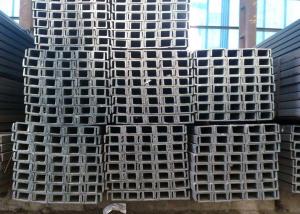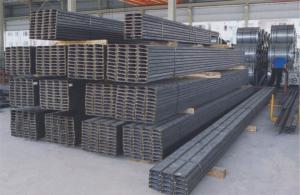U Channels in Japanese Standard with Best Price
- Loading Port:
- Tianjin
- Payment Terms:
- TT OR LC
- Min Order Qty:
- 25 m.t
- Supply Capability:
- 10000 m.t/month
OKorder Service Pledge
OKorder Financial Service
You Might Also Like
Product Description:
| Minimum Order Quantity: | 25MT | Unit: | m.t. | Loading Port: | Xingang Port |
| Supply Ability: | 120000TON/Year | Payment Terms: | TT or LC |
Product Applications:
Japanese Standard U-channels are ideal for structural applications and are widely used in the construction of buildings and bridges, and the manufacturing, petrochemical, and transportation industries.
Product Advantages:
OKorder's Japanese Standard U-channels are durable, strong, and resist corrosion.
Main Product Features:
· Premium quality
· Prompt delivery & seaworthy packing (30 days after receiving deposit)
· Corrosion resistance
· Can be recycled and reused
· Mill test certification
· Professional Service
· Competitive pricing
Product Specifications:
Manufacture: Hot rolled
Grade: Q195 – 235
Certificates: ISO, SGS, BV, CIQ
Length: 6m – 12m, as per customer request
Packaging: Export packing, nude packing, bundled
1. We are definitely speciallizing in manufacturing and supplying channel steel as per japanese standard, which is characterised with high mechanical strength and competitive prices.
Original Place | Tangshan, China | Brand Name | UINDA |
Standard | JIS G3192 : 1990 | ||
Material Grade | SS490 | ||
Sizes | 50mm to 200mm | ||
Sales Volume/Year | 3000MT | ||
Destination Area | Middle East, Africa, Southeast Asia | ||
2. The sections in details are as followings in the table-1
JIS U CHANNEL | Standard | Sectional | Dimension |
| Mass: |
| (mm) | (mm) | (mm) | (mm) |
|
50x25 | 50 | 25 | 3.0 | 6.00 | 2.37 |
75X40 | 75 | 40 | 3.8 | 7.00 | 5.30 |
75X40 | 75 | 40 | 4.0 | 7.00 | 5.60 |
75X40 | 75 | 40 | 4.5 | 7.00 | 5.85 |
75X40 | 75 | 40 | 5.0 | 7.00 | 6.92 |
|
|
|
|
|
|
100X50 | 100 | 50 | 3.8 | 6.00 | 7.30 |
100X50 | 100 | 50 | 4.2 | 6.00 | 8.03 |
100X50 | 100 | 50 | 4.5 | 7.50 | 8.97 |
100X50 | 100 | 50 | 5.0 | 7.50 | 9.36 |
|
|
|
|
|
|
125X65 | 125 | 65 | 5.2 | 6.80 | 11.66 |
125X65 | 125 | 65 | 5.3 | 6.80 | 12.17 |
125X65 | 125 | 65 | 5.5 | 8.00 | 12.91 |
125X65 | 125 | 65 | 6.0 | 8.00 | 13.40 |
|
|
|
|
|
|
150x75 | 150 | 75 | 5.5 | 7.30 | 14.66 |
150x75 | 150 | 75 | 5.7 | 10.00 | 16.71 |
150x75 | 150 | 75 | 6.0 | 10.00 | 17.90 |
150x75 | 150 | 75 | 6.5 | 10.00 | 18.60 |
150x75 | 150 | 75 | 6.5 | 10.00 | 24.00 |
|
|
|
|
|
|
200X80 | 200 | 80 | 7.5 | 11.00 | 24.60 |
Table-1
3. The mechanical property of JIS U Channel Steel in the table-2:
Grade | Yield Strength,N/mm² | Extension Strength N/mm² | |||
Thickness of Steel,mm | |||||
≦16 | >16-≦40 | >40-≦100 | >100 | ||
SS490 | ≧285 | ≧275 | ≧255 | ≧245 | 490-610 |
Table-2
4. The chemical composition of JIS U Channel Steel as per SS490 in the table-3
Grade | Element(%) | |||
C | Mn | P | S | |
SS490 | - | - | ≦0.050 | ≦0.050 |
Table-3
FAQ:
Q1: Why buy Materials & Equipment from OKorder.com?
A1: All products offered byOKorder.com are carefully selected from China's most reliable manufacturing enterprises. Through its ISO certifications, OKorder.com adheres to the highest standards and a commitment to supply chain safety and customer satisfaction.
Q2: How do we guarantee the quality of our products?
A2: We have established an advanced quality management system which conducts strict quality tests at every step, from raw materials to the final product. At the same time, we provide extensive follow-up service assurances as required.
Q3: The products are invoicing on theoritical weight or on actual weight?
A3: We can do it in both manners, according to the customers' request.
Images:


- Q: Can steel channels be used in telecommunications towers?
- Steel channels are indeed applicable in telecommunications towers. Their strength, durability, and versatility enable a range of uses. In terms of structural support, steel channels provide stability and the ability to bear heavy loads for the tower. By fabricating and assembling the channels, they form the framework of the tower, allowing for the installation of diverse equipment like antennas, transmitters, and receivers. Moreover, the design of steel channels allows for seamless integration of cables and wiring, thereby facilitating efficient connectivity throughout the tower. Ultimately, the incorporation of steel channels in telecommunications towers guarantees a robust and dependable infrastructure for effective communication networks.
- Q: What are the different methods of fastening steel channels?
- Some common methods of fastening steel channels include welding, bolting, and using specialized channel nuts and bolts. Welding involves permanently joining the channels together using heat, while bolting involves using screws, nuts, and washers to hold the channels in place. Channel nuts and bolts are specifically designed to fit into the slots or holes on the channels, providing a secure and adjustable fastening solution.
- Q: How do steel channels contribute to the overall cost-effectiveness of a wastewater treatment plant?
- Steel channels contribute to the overall cost-effectiveness of a wastewater treatment plant in several ways. Firstly, steel channels are extremely durable and have a long lifespan, which means they require minimal maintenance and replacement over time. This reduces the overall operating costs of the plant as there is less need for regular repairs or replacements, resulting in lower maintenance expenses. Secondly, steel channels provide excellent structural strength and stability. They can withstand heavy loads and pressures, ensuring the integrity of the wastewater treatment system. This eliminates the need for additional reinforcements or supports, reducing construction costs and simplifying the overall design of the plant. Additionally, steel channels offer a high degree of flexibility in terms of design and installation. They can be easily customized to fit specific project requirements, allowing for efficient use of space and resources. This adaptability helps in optimizing the layout of the treatment plant, maximizing its operational efficiency, and reducing construction costs. Furthermore, steel channels are resistant to corrosion and chemical degradation, which is crucial in a wastewater treatment environment. This resistance minimizes the need for frequent replacement or repairs due to corrosion-related issues, resulting in long-term cost savings. Lastly, steel channels are often made from recycled materials, making them an environmentally friendly option. By using recycled steel, the overall cost of production is reduced, leading to lower material costs for the wastewater treatment plant. This contributes to the cost-effectiveness of the plant while also promoting sustainability and reducing the carbon footprint associated with its construction. In conclusion, steel channels contribute to the overall cost-effectiveness of a wastewater treatment plant through their durability, structural strength, flexibility, corrosion resistance, and use of recycled materials. These factors help in minimizing maintenance and replacement costs, optimizing design and construction, maximizing operational efficiency, and promoting environmental sustainability.
- Q: Overhanging Scaffold; channel spacing
- The longitudinal horizontal rod shall be on the inside of the vertical pole, and its length shall not be less than 3 spans. Longitudinal butt joints should be staggered, two adjacent longitudinal joints should not be set in a synchronous or within the same span, not synchronous or different across the two adjacent joints staggered horizontal distance should not be less than 500mm, each jointcenter distance from the primary node is no larger than the vertical distance of 1/3. A bar two segment height should not exceed 2cm, the horizontal bar full Changping flatness can not exceed the total length of the scaffold of 1/300, and is no more than 10m.
- Q: Can steel channels be used for raised flooring systems?
- Yes, steel channels can be used for raised flooring systems. Steel channels provide excellent strength, durability, and stability, making them suitable for supporting raised floor panels and accommodating electrical and data cables in commercial and industrial buildings.
- Q: Can steel channels be painted or coated?
- Yes, steel channels can be painted or coated. Painting or coating steel channels helps to protect them from corrosion, improve their appearance, and potentially provide additional benefits such as fire resistance or increased durability.
- Q: 8 channel steel and 40*60 square steel tube, which is good in bending strength?
- The channel steel should have good flexural strength
- Q: Are steel channels suitable for the mining manufacturing industry?
- Yes, steel channels are suitable for the mining manufacturing industry. Steel channels offer high strength and durability, making them ideal for withstanding heavy loads and harsh conditions commonly found in mining operations. Additionally, steel channels can be easily fabricated and customized to meet specific requirements, making them versatile for various applications in the mining manufacturing industry.
- Q: Can steel channels be used in sports facilities?
- Sports facilities can indeed utilize steel channels. These versatile structural components offer support and stability to a variety of buildings, including sports facilities. In fact, they can be employed in the construction of bleachers, staircases, handrails, and other essential infrastructure within the facility. Due to their exceptional strength and durability, steel channels are capable of withstanding heavy loads and frequent use, both of which are common in sports facilities. Furthermore, their easy fabrication and installation allow for flexibility in design and construction. All in all, steel channels present a viable choice for integrating structural elements into sports facilities.
- Q: What are the load distribution factors for steel channel beams?
- The load distribution factors for steel channel beams depend on several factors such as the type of load, the span of the beam, and the support conditions. However, generally, the load distribution factors for steel channel beams are determined using engineering calculations and analysis techniques. These factors help determine the distribution of the applied load across the beam's cross-section, ensuring safe and efficient load-bearing capacity.
Send your message to us
U Channels in Japanese Standard with Best Price
- Loading Port:
- Tianjin
- Payment Terms:
- TT OR LC
- Min Order Qty:
- 25 m.t
- Supply Capability:
- 10000 m.t/month
OKorder Service Pledge
OKorder Financial Service
Similar products
Hot products
Hot Searches
Related keywords



























